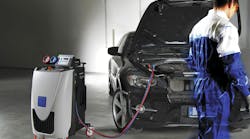Buried in the increasing chatter about semi-autonomous this and hands-free that is a feature aimed at preventing abuse of the technology: driver monitoring systems.
Now a new study from Autolist.com shows that consumers’ attitudes towards these DMS are mixed, indicating that public awareness and acceptance of them, and what they do, is still growing.
Autolist.com surveyed 1,272 current car shoppers in July to gauge consumer awareness of Advanced Driver-Assistance Systems (ADAS), DMS, and other safety systems.
The survey found that 46 percent of consumers believed a DMS should be required by law in vehicles; 35 percent said it should not be required, and 19 percent were unsure. Currently, there is no state or federal law in the U.S. requiring such a system.
But consumers’ inclination towards making such systems legal was more for the safety of the other vehicles on the road rather than to increase the safety of the vehicle with a DMS, Autolist’s survey found.
57 of respondents thought a DMS made the vehicle safer on the road for other vehicles while just 53 percent of people thought a vehicle with a DMS was itself safer.
This difference could be attributed to the relatively low number of vehicles on the road with any form of DMS. With the average age of cars and light trucks in the U.S. recently hitting nearly 12 years old according to IHS Markit, many consumers remain unfamiliar with the technology.
“We’re still in the early days of Driver Monitoring Systems so many consumers aren’t thinking of them as something they’re interacting with frequently yet,” said Chase Disher, analyst at Autolist. “Instead, they view a DMS as something that will impact them when others are using it around them.”
Autolist also found that consumers were skeptical of the impact a DMS has on driver behavior. More people said they believed Driver Monitoring Systems do not make people better drivers (42 percent) than said do (40 percent).
Age also played a role in how a consumer felt about a DMS.
The younger the driver, the more likely they were to say a DMS made a vehicle safer, both for its occupants and other drivers on the road, Autolist found.
Younger respondents were also more likely to trust passive DMS rather than active systems. For example, 68 percent of people 18 to 23 years old said a passive system was most effective whereas 51 percent of people 66 to 75 years old chose passive.
Across all age groups, 61 percent of consumers felt that a passive DMS was the most effective type.
Passive systems are the most common and they gauge driver attentiveness based on steering wheel torque (most common) or capacitive touch with the steering wheel. They’re often bundled into a group of safety-oriented driver assistance features.
Active driver monitoring systems are only available on a small number of vehicles right now; these camera-based systems use either optical or infrared cameras to monitor the driver’s attention and for driver fatigue.
Cadillac’s SuperCruise system is perhaps the best-known and most robust driver monitoring system on the market in the U.S. right now, largely because it uses an infrared camera in real-time to monitor driver eye movement and driver attention levels.
Other systems are becoming increasingly common, particularly in the luxury segment; BMW’s new X5 has a system that works in more limited conditions than Cadillac’s (it uses an optical camera rather than infrared) and Audi’s recent A8 offers such an infrared-based system in European markets but not the U.S.
Even Subaru’s latest Forester — and its upcoming Outback and Legacy models — will offer a DMS that it’s dubbed ‘DriverFocus.’
Tesla’s highly visible Autopilot system has garnered criticism from safety experts for its notable lack of a DMS. The Model 3 does have an interior camera that’s currently inactive; CEO Elon Musk has said this is a security measure for when Teslas ultimately become autonomous and owners can rent them out as ride-share vehicles. He’s also dismissed eye-tracking DMS as being ineffective.
Shoppers in Autolist’s survey indicated they were reluctant to pay much for these DMS technologies. Two-thirds of respondents (66 percent) said they would not pay more than $500 for such a feature on their next vehicle.
Subaru’s DriverFocus system is included on the top Touring trim of its Forester, which sells for $35,270.
Cadillac’s SuperCruise semi-autonomous package is a $6,000 upgrade on the two lower trims of the CT6; it’s included in the $88,000 Platinum trim. BMW’s system requires either $1,700 or $2,850 worth of package upgrades to its current X5, depending on the engine choice.

